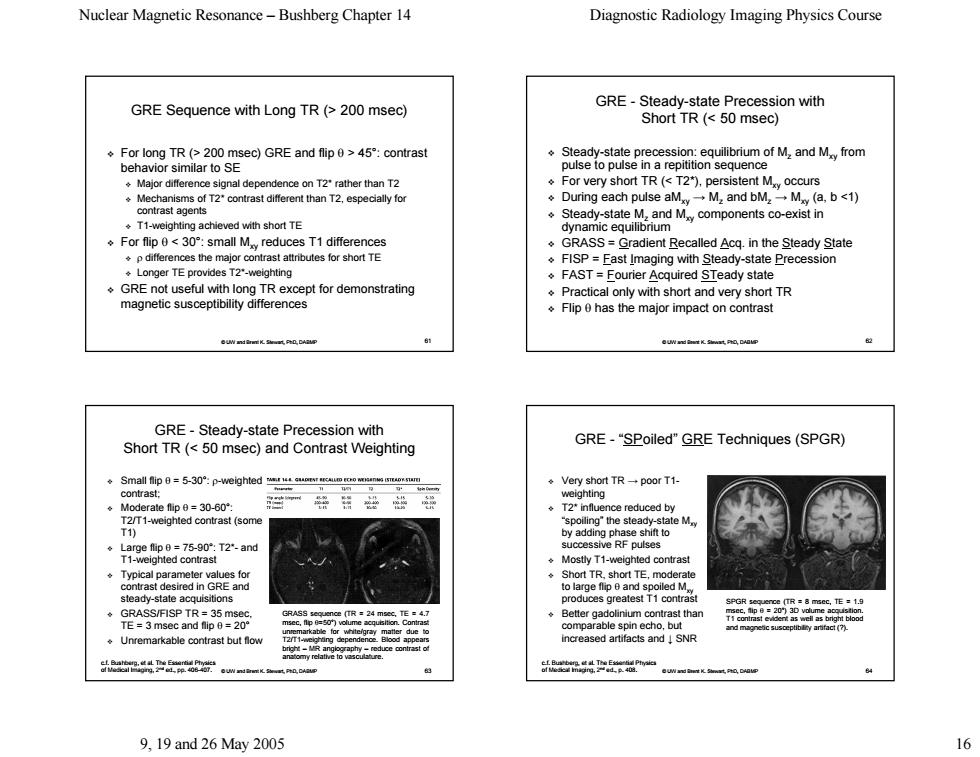正在加载图片...

Nuclear Magnetic Resonance-Bushberg Chapter 14 Diagnostic Radiology Imaging Physics Course GRE-Steady-state Precession with GRE Sequence with Long TR(>200 msec) Short TR(<50 msec) ◆For long TR(e200msec)GRE and flip0>45°:contrast Steady-state precession:equilibrium of M,and Mfrom behavior similar to SE pulse to pulse in a repitition sequence Major difference signal dependence on T2 rather than T2 For very short TR(<T2*),persistent M occurs .Mechanisms of T2contrast different than T2,especially for During each pulse aMxyM:and bM2M(a,b<1) contrast agents T1-weighting achieved with short TE Steady-state M,and M components co-exist in dynamic equilibnum ◆For flip0<30°:small M,reduces T1 differences GRASS=Gradient Recalled Acq.in the Steady State differences the major contrast attributes for short TE FISP =Fast Imaging with Steady-state Precession .Longer TE provides T2-weighting FAST=Fourier Acquired STeady state GRE not useful with long TR except for demonstrating Practical only with short and very short TR magnetic susceptibility differences Flip 0 has the major impact on contrast GRE-Steady-state Precession with Short TR(<50 msec)and Contrast Weighting GRE-"SPoiled"GRE Techniques(SPGR) ◆Small flip=5-30°:p-weighted4 ◆Very short TR一poor T1-. contrast; weighting ◆Moderate flip6=30-60 T2*influence reduced by T2/T1-weighted contrast(some "spoiling"the steady-state My T1) 。Large fip0=75-90°:T2and T1-weighted contrast Mostly T1-weighted contrast Typical parameter values for .Short TR,short TE,moderate contrast desired in GRE and to large flip e and spoiled M steady-state acquisitions produces greatest1 contras SPGR (TR =8 mec.TE 1.9 GRASS/FISP TR=35 msec. GRASS sequence(TR=24 msec,TE 4.7 Better gadolinium contrast than TE=3 msec and flip8=20° rkab comparable spin echo,but .Unremarkable contrast but flow increased artifacts and SNR 监“06 9,19and26May2005 16 Nuclear Magnetic Resonance – Bushberg Chapter 14 Diagnostic Radiology Imaging Physics Course 9, 19 and 26 May 2005 16 © UW and Brent K. Stewart, PhD, DABMP 61 GRE Sequence with Long TR (> 200 msec) GRE Sequence with Long TR (> 200 msec) For long TR (> 200 msec) GRE and flip For long TR (> 200 msec) GRE and flip θ > 45°: contrast : contrast behavior similar to SE Major difference signal dependence on T2* rather than T2 Mechanisms of T2* contrast different than T2, especially for Mechanisms of T2* contrast different than T2, especially for contrast agents T1-weighting achieved with short TE For flip For flip θ < 30°: small Mxy reduces T1 differences ρ differences the major contrast attributes for short TE Longer TE provides T2*-weighting GRE not useful with long TR except for demonstrating GRE not useful with long TR except for demonstrating magnetic susceptibility differences © UW and Brent K. Stewart, PhD, DABMP 62 GRE - Steady-state Precession with Short TR (< 50 msec) Short TR (< 50 msec) Steady-state precession: equilibrium of Mz and Mxy from pulse to pulse in a pulse to pulse in a repitition sequence For very short TR (< T2*), persistent Mxy occurs During each pulse aMxy → Mz and bMz → Mxy (a, b <1) (a, b <1) Steady-state Mz and Mxy components co-exist in exist in dynamic equilibrium GRASS = GRASS = Gradient radient Recalled ecalled Acq. in the . in the Steady State FISP = Fast Imaging with maging with Steady-state Precession FAST = Fourier Acquired cquired STeady state Practical only with short and very short TR Flip θ has the major impact on contrast has the major impact on contrast © UW and Brent K. Stewart, PhD, DABMP 63 GRE - Steady-state Precession with Short TR (< 50 msec) and Contrast Weighting Small flip Small flip θ = 5-30°: ρ-weighted weighted contrast; contrast; Moderate flip Moderate flip θ = 30-60°: T2/T1-weighted contrast (some weighted contrast (some T1) Large flip Large flip θ = 75-90°: T2*- and T1-weighted contrast weighted contrast Typical parameter values for Typical parameter values for contrast desired in GRE and contrast desired in GRE and steady-state acquisitions GRASS/FISP TR = 35 msec, GRASS/FISP TR = 35 msec, TE = 3 msec and flip TE = 3 msec and flip θ = 20° Unremarkable contrast but flow c.f. Bushberg, et al. The Essential Physics of Medical Imaging, 2nd ed., pp. 406-407. GRASS sequence (TR = 24 msec, TE = 4.7 GRASS sequence (TR = 24 msec, TE = 4.7 msec, flip θ=50°) volume acquisition. Contrast unremarkable for white/gray matter due to unremarkable for white/gray matter due to T2/T1-weighting dependence. Blood appears bright – MR angiography MR angiography – reduce contrast of anatomy relative to vasculature. © UW and Brent K. Stewart, PhD, DABMP 64 GRE - “SPoiled” GRE Techniques (SPGR) E Techniques (SPGR) Very short TR Very short TR → poor T1- weighting T2* influence reduced by T2* influence reduced by “spoiling” the steady-state Mxy by adding phase shift to by adding phase shift to successive RF pulses Mostly T1-weighted contrast weighted contrast Short TR, short TE, moderate Short TR, short TE, moderate to large flip to large flip θ and spoiled Mxy produces greatest T1 contrast produces greatest T1 contrast Better gadolinium contrast than Better gadolinium contrast than comparable spin echo, but comparable spin echo, but increased artifacts and increased artifacts and ↓ SNR c.f. Bushberg, et al. The Essential Physics of Medical Imaging, 2nd ed., p. 408. SPGR sequence (TR = 8 msec, TE = 1.9 SPGR sequence (TR = 8 msec, TE = 1.9 msec, flip θ = 20°) 3D volume acquisition. T1 contrast evident as well as bright blood and magnetic susceptibility artifact (?). and magnetic susceptibility artifact (?)